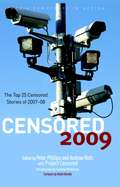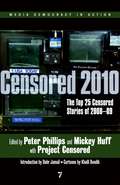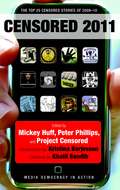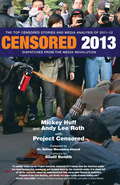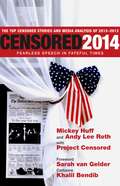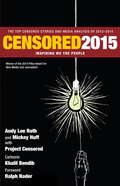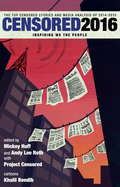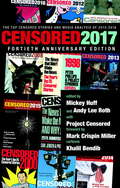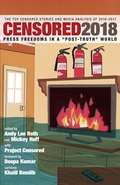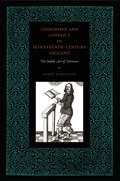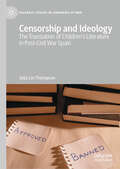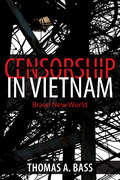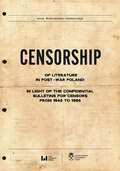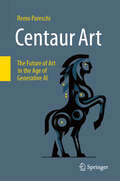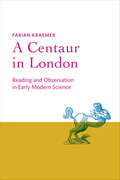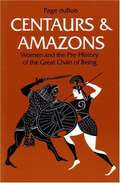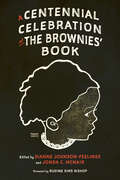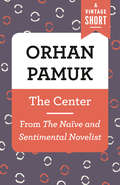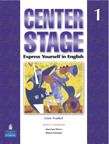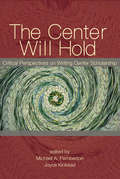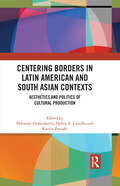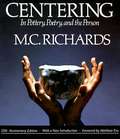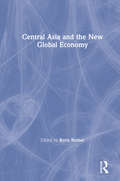- Table View
- List View
Censored 2009: The Top 25 Censored Stories of 2007-08
by Peter Phillips Khalil Bendib Project Censored Andrew Roth Cynthia MckinneyThe yearly volumes of Censored, in continuous publication since 1976 and since 1995 available through Seven Stories Press, is dedicated to the stories that ought to be top features on the nightly news, but that are missing because of media bias and self-censorship. The top stories are listed democratically in order of importance according to students, faculty, and a national panel of judges. Each of the top stories is presented at length, alongside updates from the investigative reporters who broke the stories.
Censored 2010: The Top 25 Censored Stories of 2008-09
by Peter Phillips Dahr Jamail Khalil Bendib Project Censored Mickey HuffThe yearly volumes of Censored, in continuous publication since 1976 and since 1995 available through Seven Stories Press, is dedicated to the stories that ought to be top features on the nightly news, but that are missing because of media bias and self-censorship. The top stories are listed democratically in order of importance according to students, faculty, and a national panel of judges. Each of the top stories is presented at length, alongside updates from the investigative reporters who broke the stories.
Censored 2011: The Top 25 Censored Stories of 2009 - 10
by Peter Phillips Kristina Borjesson Khalil Bendib Project Censored Mickey HuffThe yearly volumes of Censored, in continuous publication since 1976 and since 1995 available through Seven Stories Press, is dedicated to the stories that ought to be top features on the nightly news, but that are missing because of media bias and self-censorship. The top stories are listed democratically in order of importance according to students, faculty, and a national panel of judges. Each of the top stories is presented at length, alongside updates from the investigative reporters who broke the stories.
Censored 2013: The Top Censored Stories and Media Analysis of 2011-2012
by Khalil Bendib Project Censored Mickey HuffEvery year since 1976, Project Censored, our nation's oldest news-monitoring group--a university-wide project at Sonoma State University founded by Carl Jensen, directed for many years by Peter Phillips, and now under the leadership of Mickey Huff--has produced a Top-25 list of underreported news stories and a book, Censored, dedicated to the stories that ought to be top features on the nightly news, but that are missing because of media bias and self-censorship.Seven Stories Press has been publishing this yearbook since 1994, featuring the top stories listed democratically in order of importance according to students, faculty, and a national panel of judges. Each of the top stories is presented at length, alongside updates from the investigative reporters who broke the stories.Beyond the Top-25 stories, additional chapters delve further into timely media topics: The Censored News and Media Analysis section provides annual updates on Junk Food News and News Abuse, Censored Deja Vu, signs of hope in the alternative and news media, and the state of media bias and alternative coverage around the world. In the Truth Emergency section, scholars and journalists take a critical look at the US/NATO military-industrial-media empire. And in the Project Censored International section, the meaning of media democracy worldwide is explored in close association with Project Censored affiliates in universities and at media organizations all over the world.A perennial favorite of booksellers, teachers, and readers everywhere, Censored is one of the strongest life signs of our current collective desire to get the news we citizens need--despite what Big Media tells us.
Censored 2014: Fearless Speech in Fateful Times; The Top Censored Stories and Media Analysis of 2012-13
by Khalil Bendib Project Censored Mickey Huff Sarah Van Gelder Andy Lee RothEvery year since 1976, Project Censored, our nation's oldest news-monitoring group--a university-wide project at Sonoma State University founded by Carl Jensen, directed for many years by Peter Phillips, and now under the leadership of Mickey Huff--has produced a Top-25 list of underreported news stories and a book, Censored, dedicated to the stories that ought to be top features on the nightly news, but that are missing because of media bias and self-censorship. Seven Stories Press has been publishing this yearbook since 1994, featuring the top stories listed democratically in order of importance according to an international panel of judges. Beyond the Top-25 stories, additional chapters delve further into timely media topics: The Censored News and Media Analysis section provides annual updates on Junk Food News and News Abuse, Censored Deja Vu, signs of hope in the alternative and news media, and the state of media bias and alternative coveragearound the world. In the Truth Emergency section, scholars and journalists take a critical look at the US/NATO military-industrial-media empire. And in the Project Censored International section, the meaning of media democracy worldwide is explored in close association with Project Censored affiliates in universities and at media organizations all over the world.A perennial favorite of booksellers, teachers, and readers everywhere, Censored is one of the strongest lifesigns of our current collective desire to get the news we citizens need--despite what Big Media tells us.
Censored 2015
by Ralph Nader Khalil Bendib Project Censored Mickey Huff Andy Lee RothEvery year since 1976, Project Censored, our nation's oldest news-monitoring group--a university-wide project at Sonoma State University founded by Carl Jensen, directed for many years by Peter Phillips, and now under the leadership of Mickey Huff--has produced a Top-25 list of underreported news stories and a book, Censored, dedicated to the stories that ought to be top features on the nightly news, but that are missing because of media bias and self-censorship.A perennial favorite of booksellers, teachers, and readers everywhere, Censored is one of the strongest life-signs of our current collective desire to get the news we citizens need--despite what Big Media tells us.From the Trade Paperback edition.x havens. . . . And so much more that didn't make the front page (or even back page). Informative and timely, appalling and sometimes uplifting, Censored alerts readers to the stories that were quashed in favor of media bias, celebrity scandals, and self-censorship, in hopes that we the people, armed with knowledge, put our bodies upon the gears--before it's too late.From the Trade Paperback edition.
Censored 2016
by Project Censored Mickey Huff Andy Lee RothThe annual yearbook from Project Censored features the year's most underreported news stories, striving to unmask censorship, self-censorship, and propaganda in corporate-controlled media outlets. Censored 2016 features the top-25 most underreported stories, as voted by scholars, journalists, and activists across the country and around the world, as well as chapters exploring timely issues from the previous year with more in-depth analysis.
Censored 2017
by Andy Lee Roth Khalil Bendib Mickey Huff Project CensoredThe annual yearbook from Project Censored features the year's most underreported news stories, striving to unmask censorship, self-censorship, and propaganda in corporate-controlled media outlets. Featuring the top 25 most underreported stories, as voted by scholars, journalists, and activists across the country and around the world, as well as chapters exploring timely issues from the previous year with more in-depth analysis.From the Trade Paperback edition.
Censored 2018: The Top Censored Stories and Media Analysis of 2016-2017
by Mickey Huff Andy Lee Roth Project Censored Khalil Bendib"[Censored] should be affixed to the bulletin boards in every newsroom in America. And, perhaps, read aloud to a few publishers and television executives."--RALPH NADERThe annual yearbook from Project Censored features the year's most underreported news stories, striving to unmask censorship, self-censorship, and propaganda in corporate-controlled media outlets. Featuring the top 25 most underreported stories, as voted by scholars, journalists, and activists across the country and around the world, as well as chapters exploring timely issues from the previous year with more in-depth analysis.
Censored Books: Critical Viewpoints
by Nicholas J. Karolides Lee Burress John D. KeaneShort essays on a myriad of books which have been censored in the past.
Censorship and Conflict in Seventeenth-Century England: The Subtle Art of Division (Penn State Series in the History of the Book)
by Randy RobertsonCensorship profoundly affected early modern writing. Censorship and Conflict in Seventeenth-Century England offers a detailed picture of early modern censorship and investigates the pressures that censorship exerted on seventeenth-century authors, printers, and publishers. In the 1600s, Britain witnessed a civil war, the judicial execution of a king, the restoration of his son, and an unremitting struggle among crown, parliament, and people for sovereignty and the right to define “liberty and property.” This battle, sometimes subtle, sometimes bloody, entailed a struggle for the control of language and representation. Robertson offers a richly detailed study of this “censorship contest” and of the craft that writers employed to outflank the licensers. He argues that for most parties, victory, not diplomacy or consensus, was the ultimate goal. This book differs from most recent works in analyzing both the mechanics of early modern censorship and the poetics that the licensing system produced—the forms and pressures of self-censorship. Among the issues that Robertson addresses in this book are the workings of the licensing machinery, the designs of art and obliquity under a regime of censorship, and the involutions of authorship attendant on anonymity.
Censorship and Conflict in Seventeenth-Century England: The Subtle Art of Division (Penn State Series in the History of the Book)
by Randy RobertsonCensorship profoundly affected early modern writing. Censorship and Conflict in Seventeenth-Century England offers a detailed picture of early modern censorship and investigates the pressures that censorship exerted on seventeenth-century authors, printers, and publishers. In the 1600s, Britain witnessed a civil war, the judicial execution of a king, the restoration of his son, and an unremitting struggle among crown, parliament, and people for sovereignty and the right to define “liberty and property.” This battle, sometimes subtle, sometimes bloody, entailed a struggle for the control of language and representation. Robertson offers a richly detailed study of this “censorship contest” and of the craft that writers employed to outflank the licensers. He argues that for most parties, victory, not diplomacy or consensus, was the ultimate goal. This book differs from most recent works in analyzing both the mechanics of early modern censorship and the poetics that the licensing system produced—the forms and pressures of self-censorship. Among the issues that Robertson addresses in this book are the workings of the licensing machinery, the designs of art and obliquity under a regime of censorship, and the involutions of authorship attendant on anonymity.
Censorship and Ideology: The Translation of Children's Literature in Post-Civil War Spain (Palgrave Studies in Languages at War)
by Julia Lin ThompsonThis book offers a fascinating picture of how state censorship affected children’s literature translation in post-Civil War Spain. Focusing on the Spanish translations of Mark Twain’s children’s classics The Adventures of Tom Sawyer and The Adventures of Huckleberry Finn, the author traces the evolution of the censorship system of the Francoist regime and its impact on Spanish children’s literature during the years after the Spanish Civil War. Drawing on the regime’s censorship laws, official censors’ records, and textbooks, she not only examines the censorship imposed on the translations of Twain’s works, but also offers insights into the intricate connections between state censorship and the regime’s educational aims. The book gives a revealing analysis of the ways in which the highly bureaucratic censorship apparatus operated under Franco’s dictatorship, outlining the flaws and fallacies within it, as well as the strategies adopted by publishers and translators to resist the power of the state. While centred on Francoist Spain, the book also explores broader themes of ideology, censorship, and translation, making it a valuable source for scholars of translation studies and Hispanic studies, as well as those with a wider interest in literature, history, and cultural studies.
Censorship in Vietnam: Brave New World
by Thomas A. BassWhat does censorship do to a culture? How do censors justify their work? What are the mechanisms by which censorship -- and self-censorship -- alter people's sense of time and memory, truth and reality? Thomas Bass faced these questions when The Spy Who Loved Us, his account of the famous Time magazine journalist and double agent Pham Xuan An, was published in a Vietnamese edition. When the book finally appeared in 2014, after five years of negotiations with Vietnamese censors, more than four hundred passages had been altered or cut from the text.After the book was published, Bass flew to Vietnam to meet his censors, at least the half dozen who would speak with him. In Censorship in Vietnam, he describes these meetings and examines how censorship works, both in Vietnam and elsewhere in the world. An exemplary piece of investigative reporting, Censorship in Vietnam opens a window into the country today and shows us the precarious nature of intellectual freedom in a world governed by suppression.
Censorship of Literature in Post-War Poland: In Light of the Confidential Bulletins for Censors from 1945 to 1956
by Anna Wiśniewska-GrabarczykCensorship of Literature in Post-War Poland in the Light of Confidential Bulletins for Censors from 1945 to 1956, reconstructs and presents ways to censor literature (and, contextually, other fields of art) submitted for evaluation to the main censorship office in Poland during the first 11 years after WWII. The source material consists of confidential Bulletins – periodicals addressed to the officials of the censorship office.The book is divided into three main parts, each preceded by an introduction and concluded with an extensive bibliography.Part One: In Search of a Definition: What Were the Confidential Bulletins for Censors? Characteristics of the Source Material presents basic information about the Bulletins – their goals, structure, and material presented in them. The analysis concludes with the definition of confidential Bulletins of the censorship office.Part Two: Literature and Current Literary Phenomena Preconstructs the image of literary life presented in the Bulletins from 1945 to 1956. On numerous occasions, the Bulletins provided helpful guidelines in censorship practice. They discussed the job of dealing with literary texts and often gave examples of works published just a few months earlier or those that had not passed the scrutiny. The Bulletins published materials discussing literary phenomena and other issues. The ones previously unaccounted for (including film, radio and theatre), as well as the institutional background of control, I discuss briefly in the last part – Camera Censorica. What Else was Discussed in the Bulletins?.The materials presented in these confidential periodicals came from the Bulletins headquarters, field offices, and the work of censors. At the end of my study, Author let the censors speak. In the chapter Before the Proper Summary, or… the Censor as an Artist: The Literary Work of the Functionaries of Mysia Street and Its Environs, Author cite evidence of the literary ambitions of political functionaries – as censors had been called in the 1950s.
Centaur Art: The Future of Art in the Age of Generative AI
by Remo PareschiGenerative AI is transforming the landscape of numerous industries, and the creative fields are no exception. As the figurative arts become a focal point in the ongoing debate, this book explores hybrid and centauric intelligence—an integration of human and artificial intelligence. Through parallel and complementary directions, it investigates the general concept of this hybrid intelligence and its specific application in the artistic realm, highlighting the unprecedented creativity and innovation that can emerge from this synergy. Additionally, it addresses the economic tensions and legal disputes, particularly around copyright, that arise from the impact of new technologies in the creative sector. The result is a comprehensive overview of the hybridization paradigm by analyzing the operational and creative methods of artists and creators who have embraced generative AI. The author examines the implications of the recent developments, offering readers an understanding of how AI can support human creativity rather than replace it. Thus, a compelling vision of the future unfolds, one in which artists and AI collaborate, pushing the boundaries of what is artistically achievable. Whether you are a seasoned professional looking to incorporate AI into your creative process or a curious reader intrigued by the convergence of art and technology, the book will provide valuable insights and inspire you to explore the fascinating intersection of human creativity and artificial intelligence and the future it heralds for the art world.
A Centaur in London: Reading and Observation in Early Modern Science (Information Cultures)
by Fabian KraemerA nuanced reframing of the dual importance of reading and observation for early modern naturalists.Historians traditionally argue that the sciences were born in early modern Europe during the so-called Scientific Revolution. At the heart of this narrative lies a supposed shift from the knowledge of books to the knowledge of things. The attitude of the new-style intellectual broke with the text-based practices of erudition and instead cultivated an emerging empiricism of observation and experiment. Rather than blindly trusting the authority of ancient sources such as Pliny and Aristotle, practitioners of this experimental philosophy insisted upon experiential proof. In A Centaur in London, Fabian Kraemer calls a key tenet of this master narrative into question—that the rise of empiricism entailed a decrease in the importance of reading practices. Kraemer shows instead that the early practices of textual erudition and observational empiricism were by no means so remote from one another as the traditional narrative would suggest. He argues that reading books and reading the book of nature had a great deal in common—indeed, that reading texts was its own kind of observation. Especially in the case of rare and unusual phenomena like monsters, naturalists were dependent on the written reports of others who had experienced the good luck to be at the right place at the right time. The connections between compiling examples from texts and from observation were especially close in such cases. A Centaur in London combines the history of scholarly reading with the history of scientific observation to argue for the sustained importance of both throughout the Renaissance and provides a nuanced, textured portrait of early modern naturalists at work.
Centaurs And Amazons: Women And The Pre-history Of The Great Chain Of Being (Women And Culture)
by Page DuBoisIn Centaurs and Amazons, Page duBois offers a prehistory of hierarchy. Using structural anthropology, symbolic analysis, and recent literary theory, she demonstrates a shift in Greek thought from the fifth to the fourth century B.C. that had a profound influence upon subsequent Western culture and politics. Through an analysis of mythology, drama, sculpture, architecture, and Greek vase painting, duBois documents the transition from a system of thought that organized the experience of difference in terms of polarity and analogy to one based upon a relatively rigid hierarchical scheme. This was the beginning of "the great chain of being," the philosophical construct that all life was organized in minute gradations of superiority and inferiority. This scheme, in various guises, has continued to influence philosophical and political thought. The author's intelligent and discriminating use of scholarship from various fields makes Centaurs and Amazons an impressive interdisciplinary study of interest to classicists, feminist scholars, historians, art historians, anthropologists, and political scientists.
A Centennial Celebration of The Brownies’ Book (Children's Literature Association Series)
by Dianne Johnson-Feelings and Jonda C. McNairContributions by Jani L. Barker, Rudine Sims Bishop, Julia S. Charles-Linen, Paige Gray, Dianne Johnson-Feelings, Jonda C. McNair, Sara C. VanderHaagen, and Michelle Taylor WattsThe Brownies’ Book occupies a special place in the history of African American children’s literature. Informally the children’s counterpart to the NAACP’s The Crisis magazine, it was one of the first periodicals created primarily for Black youth. Several of the objectives the creators delineated in 1919 when announcing the arrival of the publication—“To make them familiar with the history and achievements of the Negro race” and “To make colored children realize that being ‘colored’ is a beautiful, normal thing”—still resonate with contemporary creators, readers, and scholars of African American children’s literature. The meticulously researched essays in A Centennial Celebration of "The Brownies’ Book" get to the heart of The Brownies’ Book “project” using critical approaches both varied and illuminating. Contributors to the volume explore the underappreciated role of Jessie Redmon Fauset in creating The Brownies’ Book and in the cultural life of Black America; describe the young people who immersed themselves in the pages of the periodical; focus on the role of Black heroes and heroines; address The Brownies’ Book in the context of critical literacy theory; and place The Brownies’ Book within the context of Black futurity and justice. Bookending the essays are, reprinted in full, the first and last issues of the magazine. A Centennial Celebration of "The Brownies’ Book" illuminates the many ways in which the magazine—simultaneously beautiful, complicated, problematic, and inspiring—remains worthy of attention well into this century.
The Center: From The Naïve and the Sentimental Novelist (A Vintage Short)
by Orhan PamukA Vintage Shorts selection. Taking us through his journey as a novelist and as a reader, Nobel Prize-winner Orhan Pamuk explores, with extraordinary insight, what constitutes what he calls “the center” of a work of fiction. Looking to works by writers as varied as Herman Melville and Virginia Woolf among many others, Pamuk examines the deeper reaches that emerge when we, as writers and readers, suspend our judgments and search for meaning inside the pages of a book, encouraging us all to do the same. An ebook short.
Center Stage 1: Express Yourself in English
by Irene Frankel Maryann Florez Sharon SeymourCenter Stage 1: Express Yourself in English , by Irene Frankel (Series Consultants: MaryAnn Florez and Sharon Seymour), gives your students the communicative skills to start using English effectively in their daily lives. Center Stage 1 is an integrated four-skills course that supports student learning and achievement. Practical language and timely topics motivate beginning students to master grammar along with speaking, listening, reading, and writing skills.
Center Will Hold: Critical Perspectives On Writing Center Scholarship
by Michael PembertonIn The Center Will Hold, Pemberton and Kinkead have compiled a major volume of essays on the signal issues of scholarship that have established the writing center field and that the field must successfully address in the coming decade. The new century opens with new institutional, demographic, and financial challenges, and writing centers, in order to hold and extend their contribution to research, teaching, and service, must continuously engage those challenges. Appropriately, the editors offer the work of Muriel Harris as a key pivot point in the emergence of writing centers as sites of pedagogy and research. The volume develops themes that Harris first brought to the field, and contributors here offer explicit recognition of the role that Harris has played in the development of writing center theory and practice. But they also use her work as a springboard from which to provide reflective, descriptive, and predictive looks at the field.
Centering Borders in Latin American and South Asian Contexts: Aesthetics and Politics of Cultural Production
by Debaroti ChakrabortyThis book presents inter-disciplinary research on contemporary borders with contributions from scholars and cultural practitioners located in different contexts in the Americas and South Asia. There has been significant sociological work on borders; however there is a relative dearth of humanities research on contemporary border realities, particularly in South Asia. This volume introduces frameworks of critical insights and knowledge on border narratives and cultural productions. It addresses and goes beyond the impact of the partition in South Asia to train a unique comparative and aesthetic lens on borders and borderlands in relation to Latin America and the U.S.A. through oral narratives, photographs, ‘objects’, films, theatre, journals, and songs. It maps border perspectives and their reception in a framework of cultural politics. It revolves around themes such as violence and modes of survival; women’s narratives of migration, trafficking and incarceration; abduction of children; vulnerability as experience; rationalities of mass killings; and proliferation of countercultures to map border perspectives in a framework of cultural politics. First of its kind, the volume will be useful to scholars and researchers of comparative literary and cultural studies, South Asian studies, Latin American studies, border studies, arts and aesthetics, visual studies, sociology, comparative politics, international relations, and peace and conflict resolution studies.
Centering in Pottery, Poetry, and the Person (2nd edition)
by Mary Caroline RichardsA discussion of how to balance life through use of pottery, poetry and education. The book uses examples of the author's poetry.
Central Asia and the New Global Economy: Critical Problems, Critical Choices
by Boris Z. RumerCentral Asia's new states have been buffeted by financial ill winds from East Asia and Russia and by Islamic revolutionary movements from the south. In the context of widespread and deepening impoverishment, endemic corruption, gaping inequalities, and external pressures to undertake difficult reforms, economic crisis threatens to expand into profoundly destabilizing social and political crises as well.This volume analyzes the geopolitical and macroeconomic situation of Central Asia, local policy responses to the current crisis, and alternative scenarios for the foreseeable future. It devotes particular attention to Kazakhstan, Turkmenistan, and Uzbekistan. Beyond the immediate case, the book focuses on policy measures and institutional improvements that could most directly impact the capacity of economies in the region to adapt to the globalization process.
